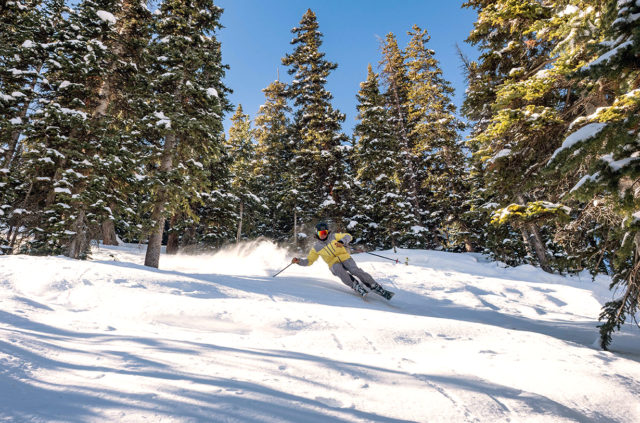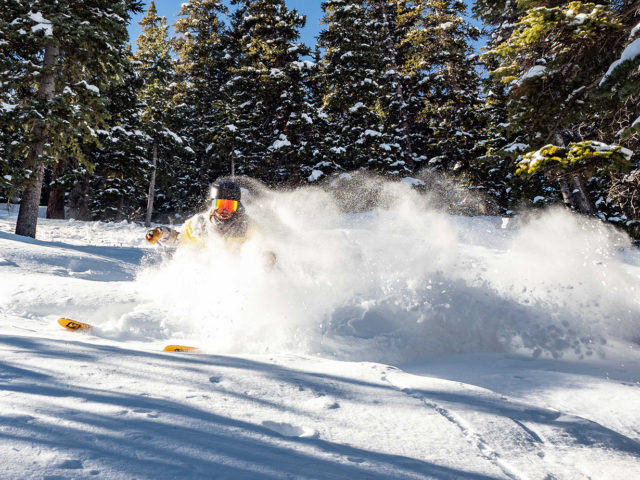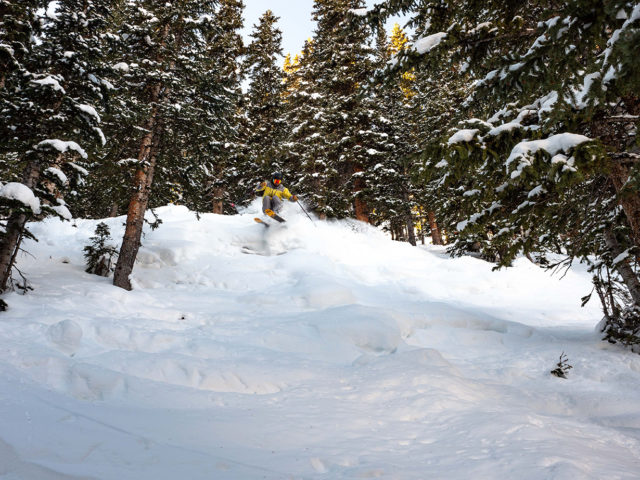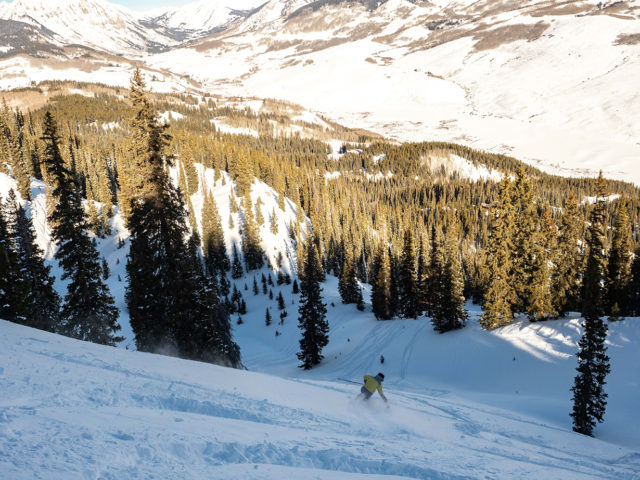TREW Capow Jacket & Bib
Test Locations: Crested Butte, Aspen, & Rocky Mountain National Park; Colorado
Days Tested: ~15
Reviewers:
- Sam Shaheen: 5’10”, 145 Ibs
- Luke Koppa: 5’8”, 155 lbs
TREW Capow Jacket
Size Tested: Medium
Blister’s Measured Weight (size Medium): 571 grams
Fabric:
- Hood & Shoulders: 3-layer Dermizax EV w/ 150-denier nylon face fabric
- Rest of Jacket: 3-layer Dermizax EV w/ 50-denier nylon face fabric
Stated Features:
- Helmet-compatible hood with internal elastic for a contoured fit
- Single-point back-hood adjustment with Cohaesive cord locks
- Underarm zip vents
- Microsuede chin guard
- Laser-cut PU logos
- Rubber-tipped cordage zipper pulls
- Shock cord adjustable hem
- Cohaesive® embedded cord locks at hem
- RECCO® reflector
Pockets:
- 2 exterior chest pockets (zippered)
- 2 exterior hand pockets (zippered)
- 2 interior drop-in pockets
MSRP: $449
TREW Capow Bib
Size Tested: Medium
Blister’s Measured Weight (size Medium): 824 grams
Materials:
- Main Fabric: 3-layer Dermizax EV w/ 150-denier nylon face fabric
- Upper Bib: stretch-woven nylon
- Cuff Reinforcements: “Superfabric”
Stated Features:
- Adjustable shoulder straps with no-slip gripper
- New 2019 sliplocks on shoulder strap for added stability
- Superfabric cuff guard and instep protection
- 3/4 length side zip and top opening on wearer’s right side
- Half-length side zip on wearer’s left side
- Center-front zipper for main opening with two-way sliders (New 2019)
Pockets:
- 2 hand pockets (zippered)
- 2 thigh pockets (zippered)
- 1 beacon pocket (zippered)
- 1 chest pocket (zippered)
MSRP: $449
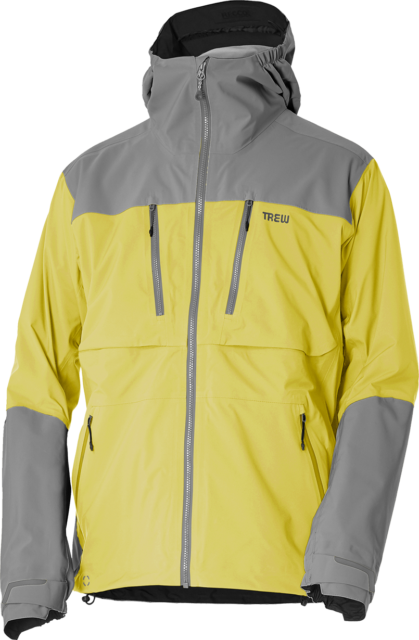

Intro
TREW designed the Capow kit in collaboration with CAPOW Guiding, based in Revelstoke, British Columbia. TREW said about the kit: “our task was to build a jacket breathable enough to stay on for the uphill, durable enough for guiding, and fully stormproof and ready to dominate the downhill.”
Sam Shaheen and I have both been using the Capow kit this season, taking it out on everything from long days in the backcountry to inbounds laps in Crested Butte. Here’s our take on the kit:
Fit — Capow Jacket
Sam Shaheen (5’10”, 145 lbs): In the realm of backcountry-focused hardshells, the Capow Jacket has a pretty average fit. It falls somewhere between the more freeride-inspired fit of The North Face’s Freethinker Jacket and the more minimal, alpine cut of the Patagonia Ascensionist Jacket.
The torso is roomy enough for me to fit a few midweight insulating layers under and the sleeves have plenty of length to keep my wrists from getting exposed when making big reaches (some might find the sleeves a bit too long) and the hem hits me just below my butt when standing up (though it isn’t quite long enough for butt coverage while I’m sitting).
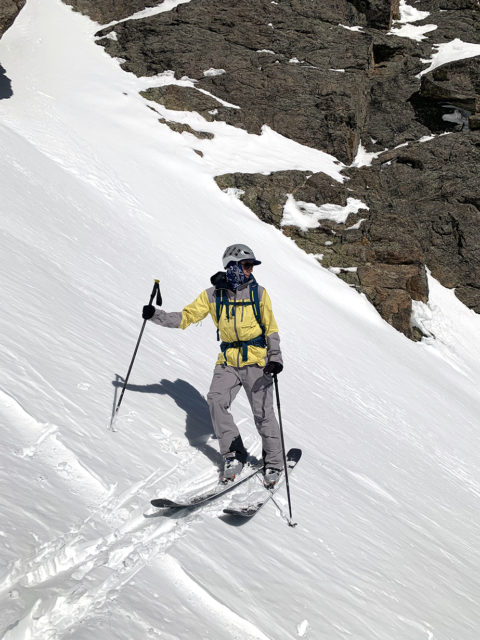
This jacket has plenty of room in all directions for just about everything I would want to do in the backcountry without quite looking like it has a freeride aesthetic. I’m a big fan of the fit on the jacket.
Luke Koppa (5’8”, 155 lbs): Yep. The Capow Jacket is slimmer than most resort-focused shells I’ve used, and pretty average for a backcountry shell. Enough room to work for any of my layering systems, without feeling excessively bulky in the backcountry. The main thing I’ll add is that, at 5’8”, I think the size Medium is perfect for me — the hem hits right around my hips and I haven’t found the sleeves to feel too long.
Fit — Capow Bibs
Sam: The fit of the bibs is similar to the jacket: somewhere between freeride baggy and alpine slim — with an extended inseam and a high-chested bib.
For a size Medium (my usual size), the inseam feels really long on the Capow Bib, which has led to some problems for me.
For one, the bottom of the pants tend to significantly bunch up. This generally isn’t a big problem, but if I have to use crampons, the cuffs get stabbed pretty easily. The cuffs also drag on the ground if I don’t have my boots on, which means I have to roll them up whenever I’m not wearing my ski boots.
The crotch is also pretty high. Usually, I would just crank down on the suspender straps to make the whole pant sit a bit higher and decrease bunching at the cuffs, but I can’t do that with the Capow due to the crotch height.
I don’t think the leg length will be an issue to taller people or for people who are used to longer-cut resort pants. I’ve just gotten so used to shorter pants lately, or to pants that allow me to adjust them to the exact length I prefer with their suspenders.
The other thing I want to talk about with the fit of the Capow Bib is the bib itself. The bib is very high waisted and comes up very high on my chest and back. This is excellent for protection in deep snow, resort riding, or riding without a pack (generally, a pack’s hip belt keeps all the snow out of the bottom of my jackets, regardless of bib height) but presents two main problems: fit and breathability.
Because the bib comes up so high, I think people with larger chests will want to either size up and / or try the Capow on before buying. I have a pretty slim build at 5’10” and 145 lbs, and I wouldn’t want the bib to be much snugger around my chest.
The high-waisted bib also significantly limits breathability by covering much of the chest with several layers of fabric. On hot days, I often skin in just a baselayer. When wearing the Capow Bib, I find myself unzipping the fly for additional ventilation around the chest, which I don’t find myself doing in other kits (but the big caveat is that I also rarely tour in bibs, anyway — more on that later).
Speaking of the fly, the bottom of the fly is oddly high on me which makes it difficult to … do things that you use a fly for.
All of this makes the Bib have a more “freeride feeling fit” than the jacket does, even though the leg width isn’t all that wide. In my mind, the cut (and feature set) make the Capow Bib feel a bit more resort-oriented than the jacket.
Luke: This is interesting to read. Personally, I loved the fit of the Capow Bib, but I also haven’t hacked my way up any couloirs in it with crampons on my feet.
The “pant” part of the Capow Bib is moderate in terms of volume. Like the Capow Jacket, I’d say it falls somewhere between skimo touring pants and baggy resort pants.
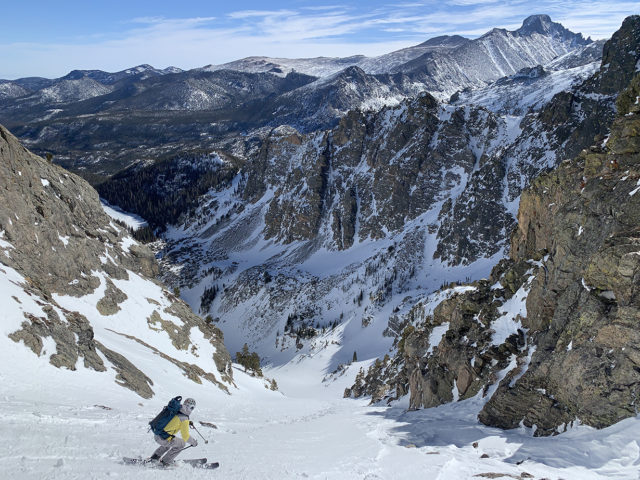
The upper bib portion of the Capow Bib is pretty slim, but I’ve actually loved that. Maybe it’s just how it fits my body type, but wearing the Capow Bib feels like I’m being comfortably hugged by the bib. It also helps to keep the bib from moving around on my body. But I agree with Sam in that those with very broad chests should try on this bib before buying (I wouldn’t want it to be much slimmer than it is).
Regarding Sam’s notes on the length of the inseam / leg, I haven’t found this to be an issue, despite being 2 inches shorter than Sam, but I also haven’t been climbing up anything with pointy things on my feet in this kit. And as a 5’8” person who almost always wears size Medium outerwear, I’m used to having extra fabric around my feet, so that probably plays into it. With that said, I would either size down or go to a pant with a slimmer lower-leg if I was going to be doing a lot of technical alpine climbing.
Probably since I’m shorter, have long legs relative to my torso size, and don’t care about having extra fabric bunched up at the cuffs, the location of the fly on the Capow Bib has worked fine for me.
I guess the point we’re making here is that, if possible, you should try on the Capow Bib before buying. The overall volume is nothing crazy, but the longer legs and tighter bib area do make the fit a bit more complicated.
Features — Capow Jacket
Sam: The Capow Jacket has a pretty standard feature set with a few unique things thrown in.
The pocket setup is pretty typical: two high chest pockets with waterproof zips that are accessible with a pack and two waterproof-zip hand pockets that sit low on the jacket and get obscured with a hip belt. The Capow Jacket also has two elastic drop-in pockets on the interior of the jacket.
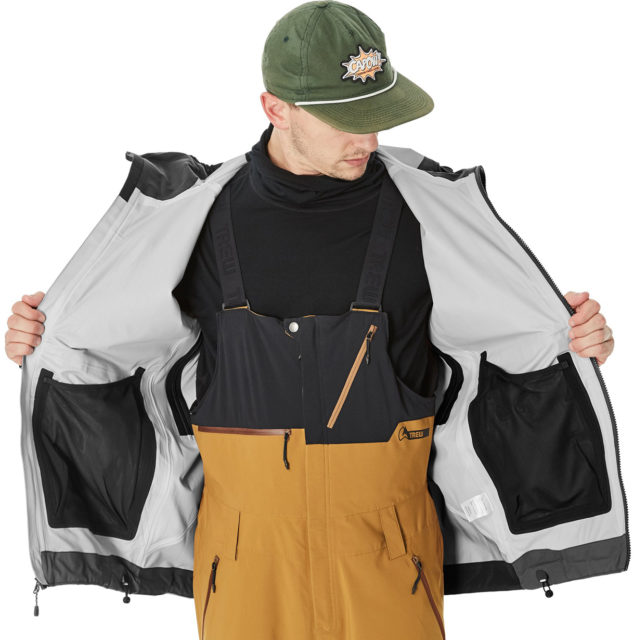
None of these pockets are very large, but you can jam most skins in the drop-in pockets. The exterior zippered pockets probably aren’t big enough for skins unless your skins are very packable and cut for fairly small skis.
The jacket has 16” (41 cm) pit zips with dual zipper pulls that provide a pretty good level of ventilation.
The hood is adjustable by a single drawcord pull on the back and has the unique feature (by today’s standards, at least) of pre-tensioned elastic sections on either side of the opening of the hood. This seems to be in lieu of the two drawcord adjustments that many modern hoods use to tension this part of the hood. This setup seems to work ok as I rarely find myself adjusting those shocks cords on other hoods anyway, but the aesthetic created by the little zone of bunched of fabric is distinctly dated in my mind.
Luke: Personally, I don’t mind the elastic-look of the hood opening on the Capow Jacket, and I almost never use those sorts of adjustments on my ski shells anyway. With the hood over my helmet, I thought the elastic sections did a good job of keeping the hood secure, though the range of motion with the hood up doesn’t feel quite as friction-free as most Arc’teryx hoods I’ve used (in my experience, Arc’teryx’s hood patterning is unrivaled, and they’re more of the exception than the rule).
The one downside to the elastic (or maybe just the patterning of the hood) is that it decreases the volume of the collar / hood area, making it feel a bit tight on my neck and chin when I had both a midlayer and back protector (Shred Flexi Back Protector Naked) underneath the Capow Jacket. I don’t usually wear my back protector in the backcountry so I don’t see this as a big issue, given the intended use of the Capow kit, but something to note if you do wear a bulky back protector and / or have a big chest.
Other than that, I really like the dual chest pockets, handwarmer pockets that are comfortable to actually put your hands in (since they’re not pack-compatible and are therefore pretty low on the torso), and the dual-sided zips on the underarm vents are a necessity IMO for a backcountry shell. As someone who likes to put my skins in my jacket, I wish the exterior pockets were bigger and could fit skins, but stashing them inside the jacket is fine and better for keeping skins drier / warmer.
Features — Capow Bib
Sam: The Capow Bib is a fully featured bib with two hand pockets and two bellowed thigh pockets on the lower pants. The bib portion has a beacon pocket with a sewn-in clip and a smaller zippered stash pocket that is quite small and can fit a ski pass, lip balm, etc.
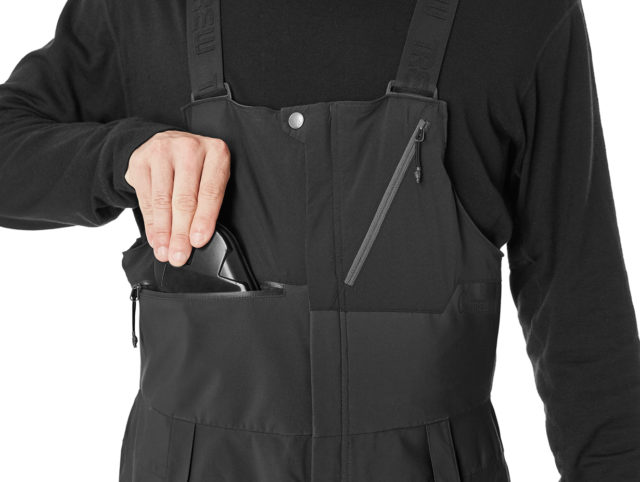
The Capow Bib has what I’d call a “half drop seat.” There is one zipper on the right side that extends all the way up to the top of the bib. It is not as effective as a traditional drop seat that uses full-length zippers on both sides, but in a pinch, you could do your business with this setup. It would be awkward, but not impossible.
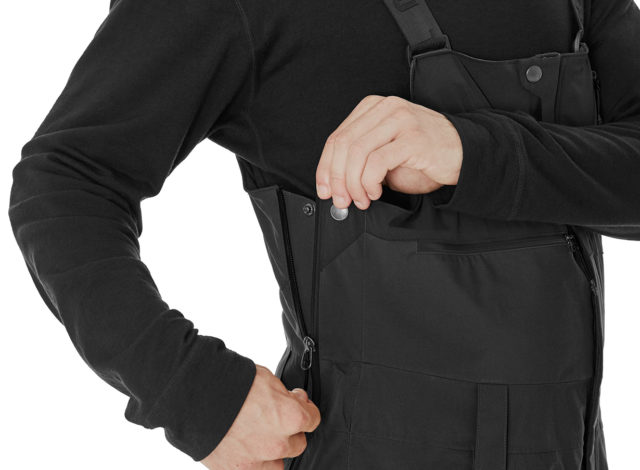
There are 4 different zippered vents on the Capow Bib, all of which are unlined. One on the inside of each leg and one on the outside of each leg (one of the outside vents serves as the half-drop-seat). These provide for a good level of venting in most conditions. With all the vents opened up, there is a lot of airflow in these pants.
The suspenders on the bib are elastic, adjustable, and have a silicone strip on the inside to keep them from slipping off your shoulders. The cuffs have a durable patch of what Trew calls “Superfabric” to protect from ski edges and crampon points and a reliable snow gaiter that fits over all the ski boots we’ve used (touring & alpine).
Luke: Overall, I really like the feature set of the Capow Bib. Granted, it’s not minimal and definitely adds some weight, but I’ve found myself using most of the features, so I don’t view them as wasted weight.
The four vents create a ton of airflow when fully opened. And while I don’t often open all the vents on other pants, since the Capow Bib fits me so securely, I don’t notice it sagging or feeling super clunky when I have all four vents wide open.
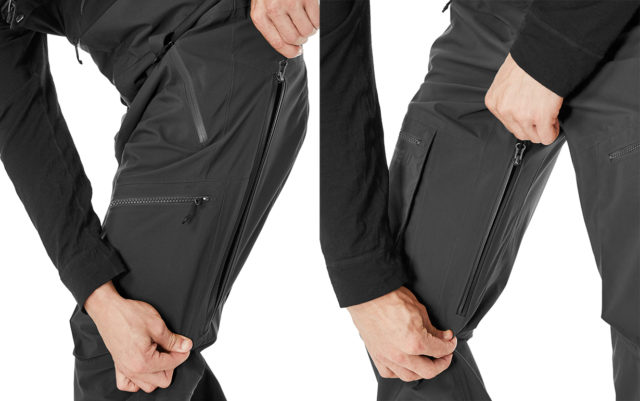
I love the bib’s beacon pocket (it also makes a great phone pocket for resort skiing when you don’t have a beacon). I like the lower-thigh pockets for stashing gloves or other quick-access items, though I wouldn’t put anything very heavy in them as they sit pretty close to my knees. I think the suspenders’ silicone gripper on the inside is great, and I love that Trew still put belt loops on the exterior. While many pants have useful built-in adjustments, I always prefer to at least have the option of adding a belt in case I ever decrease my donut consumption (or you’re between sizes…).
The “Superfabric” cuff reinforcements are fairly supple, which I like since they’re less prone to bunch up and provide a catching point for crampons and ski edges, which is often an issue with reinforcements that are super stiff. That said, the potential extra fabric from the length of the bibs does kind of counteract this. But I also like that there’s a bit of that “Superfabric” all around the very edge of the cuff — on pants that only have reinforced fabric on the inside of the cuff, I find myself still managing to slice the lower portions of the cuff in the front, back, and outside of the cuffs. I haven’t managed to tear any portion of the cuffs on the Capow Bib so far.
Weight
Sam: The difference in weight between the Capow Jacket and Bibs is pretty drastic. The bib is much heavier than the jacket, and relative to some other pants and bibs on the market. The Capow Jacket, on the other hand, is fairly average when it comes to weight, at least compared to most touring-oriented options.
This is partly due to the fact that the Capow Bib is, in fact, a bib and bibs are much heavier than other pants with lower cuts. But it is also due to the fact that the Capow Bib is very fully featured and uses a pretty burly fabric. Even though the bib is similar in weight to something like the Flylow Baker Bib, don’t get it confused, the fabric on the Baker Bib is much heavier and more durable than on the Capow.
Luke: All I’ll add is that I never thought about the weight of the Capow Bib, once it was on. Again, I think this comes down to how well it fits me. Weight that’s close to my skin and not hanging off any one point in particular is much less noticeable than, say, a super baggy and heavy pant where all that weight is on my waistline. That said, gram counters will probably just have to look at the list below to figure out if the Capow kit will work for them.
For reference, here’s a list of some of the other jackets and pants we’ve reviewed, and their respective weights. Note that not all of the pieces are the same size, so try to keep that in mind when making comparisons.
Jackets:
364 g Black Diamond Helio Active Shell, size Medium
366 g Patagonia Ascensionist Jacket, size Medium
435 g Arc’teryx Rush LT Jacket, size Medium
518 g Flylow Cooper Jacket, size Medium
544 g Outdoor Research Hemispheres Jacket, size Medium
563 g Rab Sharp Edge Jacket, size Medium
571 g TREW Capow Jacket, size Medium
574 g Amundsen Peak Anorak, size Medium
590 g Flylow Higgins Coat 2.1, size Large
593 g Patagonia PowSlayer Jacket, size Large
598 g The North Face Freethinker Jacket, size Medium
601 g Spyder Sanction GTX Pro Shell Jacket, size Medium
605 g Patagonia Descensionist Jacket, size Medium
610 g Strafe Cham Jacket, size Large
615 g Patagonia SnowDrifter Jacket, size Medium
626 g Arc’teryx Sabre LT Jacket, size Medium
635 g Mammut Alvier Armor Hardshell Jacket, size Medium
665 g Norrona Tamok Gore-Tex Pro Jacket, size Medium
726 g Holden M-51 Fishtail 3 Layer Jacket, size Medium
825 g The North Face Ceptor Jacket, size Medium
841 g Strafe Pyramid Jacket, size Large
848 g Open Wear Open One 3L Shell Jacket, size Medium
1047 g FW Manifest 3L Jacket, size Large
Pants:
441 g Norrona Lyngen Windstopper Hybrid Pants, size Large
485 g Strafe Cham Pants, size Large
494 g Patagonia Descensionist Pants, size Medium
539 g Arc’teryx Rush LT Pant, size Medium
555 g Open Wear Open One 3L Shell Pants, size Medium
603 g Patagonia PowSlayer Bibs, size Large
608 g Patagonia SnowDrifter Bibs, size Medium
618 g Rab Sharp Edge Pants, size Medium
620 g Arc’teryx Sabre Pants, size Large
635 g Spyder Turret GTX Shell Pants, size Medium
638 g The North Face Freethinker Pants, size Medium
723 g Black Diamond Mission Pants, size Medium
775 g FW Manifest 3L Pants, size Large
824 g TREW Capow Bib, size Medium
896 g Flylow Baker Bib, size Small
Materials
Sam: The fabric on the Capow Jacket feels supple and pretty light. It has an easy drape and soft hand feel. It also has a good amount of bias stretch (i.e., stretches at 45° relative to the direction of the weave), which makes for a pretty comfortable kit.
The shoulder and hood (grey portion) of the Capow Jacket use a 140-denier face fabric, while the rest of the jacket (yellow portion) uses a lighter 50-denier face fabric. The Capow Bibs’ main fabric uses the burlier 140-denier face fabric. The Capow Kit uses a Dermizax EV polyurethane (hydrophilic) nonporous membrane throughout, with a claimed 20K waterproof rating across the board, 20K breathability rating for the 140-denier sections, and a 45K breathability rating for the 50-denier sections used throughout much of the jacket. [For more on waterproof / breathable membranes, ratings, etc., see our Outerwear 101 article.]
The upper section of the bib is made of a stretch-woven synthetic that has a pretty good amount of stretch and enough structure to support the suspenders.
Luke: When we heard from Trew that the Capow Jacket used two different types of fabrics, I was pretty surprised. This was because I never noticed any weird draping issues or felt like the fabrics were different at all — the fit and feature set of the jacket just felt like it matched really well with the fabric.
The other thing I’ll highlight is that, as has been a theme these past few years, the Capow’s fabrics do not feel like traditional hardshells. The fabrics are very comfortable and supple. And I like that, while TREW added a stretchier, more breathable fabric at the upper bib, it’s not so stretchy and structure-less that it feels weird when supporting the weight of the bib.
Weather Resistance
Luke: I used the Capow kit on one of the deeper and wetter days this year, and it performed as I’d expect of a high-end, waterproof kit — no moisture got through. I also used it on a few other storm days after that, with the same result. Based on my experience, I have no reason to doubt the weather resistance of this kit.
Sam: Though I haven’t gotten the Capow kit out in any extremely wet conditions, after kneeling / sitting in some very wet snow I haven’t had any water leaking through the fabric. This isn’t surprising though — we rarely find hardshells anymore that don’t offer excellent resistance to precipitation (especially in the drier climate we have here in Colorado). The thing that really separates hardshell fabrics comes down to breathability…
Breathability
Sam: Often, a good way to guess the breathability of a garment is to look at the amount of ventilation that manufacturers build into their garments. The Capow jacket has pretty standard 16” (41 cm) pit zips — which correspond to the pretty average breathability of the jacket. I haven’t had any experiences where the breathability of the jacket stood out to me, whether good or bad. On the skin track, unless I’m going at very low output, I almost always have to take off the jacket. When it gets windy or starts snowing, I’ll put it on and open up the pit zips to regulate heat. This is pretty par for the course for me when it comes to waterproof shells.
The bib has 4 different ventilation zips — which is a lot. And, as you might expect with so many vents, the Capow bib needs all that ventilation as it doesn’t breathe as well as the jacket (which makes sense, given the lighter & more breathable fabric used throughout most of the jacket). Fabric differences aside, the bib section of the pant is also a big factor. Because the bib is so high and relatively form-fitting, it traps a lot of warm air and moisture, which has caused me to overheat several times on warmer days when wearing just the bib and a baselayer top.
In general, I think that bibs this high are best suited for resort-specific pants that don’t need to maximize breathability. However, if you rarely overheat on the skin track, then you might not have any issues with the Capow Bib.
Luke: Personally, I’d call the Capow Jacket slightly above average when it comes to breathability. It’s not as airy as some of the class-leaders like Gore-Tex Active or air-permeable fabrics like that in the old Patagonia Descensionist and Strafe Cham, but the Capow Jacket feels a bit more breathable than standard Gore-Tex or most jackets with proprietary 20K/20K fabrics.
I also usually skin with just a baselayer, but I spent some time on the skin track wearing the Capow Jacket over a ~140 g/m2 wool baselayer in temps ranging from 10–25°F (-12°C to -4°C) to test its breathability. I found myself opening up the vents pretty quickly, and after that, I still felt a bit hot and was sweating slightly, but I wasn’t so warm that I felt the need to immediately shed the shell. And at times when the wind picked up, I was quite comfortable. In summary, I don’t think the Capow Jacket is going to blow your mind when it comes to breathability, but it’s pretty good for a waterproof shell.
Regarding the Capow Bibs, I agree with Sam for the most part. They’re pretty average in terms of breathability, and adding more fabric anywhere is never going to help the case when it comes to keeping you cool. That said, I am glad that Trew used a non-waterproof fabric on at least some of the upper bib, since it does breathe much better than the main fabric. Also, I notice my upper body overheating far more often than my lower body, so the average breathability of the Capow Bib isn’t a huge issue for me — especially since it offers so much ventilation. For mid-winter touring in a place like Colorado, I think the breathability and ventilation of the Capow Bib would be fine for me, but I’d definitely switch to a non-bib with a more breathable and less waterproof fabric for spring and summer tours.
The bibs vs. pants debate always comes down to personal preference, and there are passionate fans on each side. For me, as someone who doesn’t ski a ton of super deep, wet snow all the time, I rarely feel the need to go with the extra fabric of a bib (FWIW, I’m also a person who hates powder skirts — maybe I just like getting snow up my jacket?). BUT, if I skied in a place like British Columbia or the US Pacific Northwest and would appreciate the extra coverage, I think the Capow Bib is a very viable touring bib. It’s not exceptionally breathable, but it is totally waterproof and all of those vents certainly help when things get sweaty.
Warmth
Sam: This kit is entirely uninsulated and as a result, has almost zero inherent warmth beside the weather protection afforded by the fabric.
Luke: Yeah, there isn’t much that’s notable here in terms of warmth. I tend to layer in the Capow kit exactly as I would with any other uninsulated shells.
Durability
Sam: So far, we haven’t had any out of the ordinary durability issues to report on. Keep in mind that the Capow kit’s fabric is fairly lightweight (particularly the jacket) and will not last as long as more burly fabrics designed for daily abuse in the resort.
Luke: No issues to report so far, and all I’d add is that, while the Capow kit doesn’t feature as burly of a fabric as some of Trew or other brands’ inbounds-oriented shells, it’s not nearly as thin and fragile as minimalistic shells like the Patagonia Ascensionist or Black Diamond Helio Active Shell.
As always, we’ll report back if we run into any durability issues down the line.
Who’s It For?
Sam: In my mind, the Capow kit is best suited for backcountry skiers and snowboarders who appreciate a high-waisted bib and value a full feature set and solid durability over absolute maximum breathability. For very high-output touring, there are more breathable kits. For the minimalists, there are much lighter options, too (especially for pants).
But if you’re looking for a high-waisted backcountry bib or full-featured, fairly lightweight 3L jacket, then the Capow is worth a look.
Luke: In addition to what Sam just described, I’d also say that the Capow kit stands out due to the fact that (1) it’s extremely comfortable, (2) it’s fully waterproof (unlike some more breathable softshell kits), and (3) its moderate fit and generous feature set make it a very viable 50/50 option that you could use in the resort and in the backcountry. I think this kit excels in the backcountry (particularly for powderhounds, rather than ski mountaineers), but I’ve happily used it in the resort. It’s not as baggy or super burly as some dedicated inbounds options, but it’s also not super lightweight, which I think makes it a very solid middle ground for a lot of people.
Bottom Line
The TREW Capow kit is a backcountry-focused kit that brings a full feature set together with a fairly lightweight, supple, and very comfortable fabric. For those seeking best-in-class breathability or those looking to save every gram, there are better options. But if you’re looking for a full feature set and a versatile fit with a comfortable fabric, the Capow should be a contender — whether you spend all of your time huffing and puffing uphill for your turns, or appreciate the occasional chairlift.

